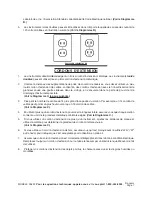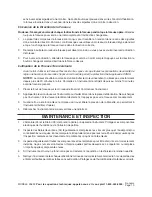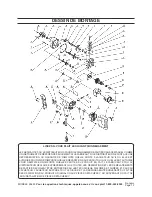
SKU 93632
For technical questions, please call 1-800-444-3353.
English
Page 8
OPERATING INSTRUCTIONS
Your Low Speed Heavy-duty Drill will usually be preassembled. In some cases, due to variations in packaging,
you may have to install the Spade Handle and Auxiliary Handle. Please refer to the assembly diagram on page
10.
CAUTION: Be sure the tool is unplugged from any power source before performing any installation
or adjustment of the tool.
1.
Align the Spade Handle (31) with the Back Case (32). Insert the Spade Handle Knob (30) through the
Spade Handle into the Back Case. Tighten the Spade Handle Knob by turning clockwise until tight.
2.
Insert the Screw (14) through the Side Handle (15). Position the Side Handle on the Gear Housing Cover
(22). Using a screwdriver (not included) tighten the Screw (14) until tight.
NOTE: Periodically check to be sure the handles remain tight. Never try to reposition the handles while
the tool is running.
About Low Speed Heavy-duty Drills:
While an extremely useful tool, heavy-duty drills can be dangerous if used improperly or in damaged
condition.
1.
This tool incorporates a double gear reduction transmission to reduce drill speed while increasing torque.
This design improves performance when drilling large holes up to 2” in wood and 1/2” in mild steel. This
feature also helps prevent the tool from “bogging down” or stopping when under heavy load.
2.
Drill Bits (not included) come in various sizes and types. Various types include low and high speed twist
bits for metals, spade or brad point bits for wood, forstner bits for flat bottomed holes in wood or plastic,
auger bits for boring through walls and floors, masonry bits for plaster and dry wall, etc. Always select the
proper bit type and size for the application at hand.
3.
This drill can use drill bit shank sizes between 1/16” and 1/2” inclusive. Boring hole size may be larger
than the shank size. Do not attempt to use drill bits larger or smaller than this range.
4.
Whenever installing a drill bit into the tool, first unplug the tool. By hand, rotate the outer ring of the Chuck
counterclockwise to open it enough to allow the bit to be inserted. Be sure the bit is centered in the
Chuck. By hand, rotate the outer ring of the Chuck clockwise to tighten on the bit. Check to be sure the
bit is centered in the jaws of the Chuck.
5.
Insert the tip of the Chuck Key into one of the openings drilled into the side of the Chuck. Engage the
gears of the Chuck Key with the gear teeth on the outside of the Chuck. Turn the Chuck Key clockwise to
tighten the jaws of the Chuck firmly on the drill bit. CAUTION: Be sure the drill bit is centered and firmly
fixed in the Chuck before beginning work.
Power Switch Features
Note: The Power Switch (46) has a variable speed feature. Simply turn the dial below the Power Switch
to adjust the drill speed. The dotted lines on the dial are spaced from narrow to wide to indicate increasing
drill speed.
Note: The trigger lock button on the Power Switch, when activated, will allow the drill to run without
continuous finger pressure on the power switch. To release the trigger lock, simply press your finger on
the power switch.
1.
Do not start the tool until you have observed all safety preparations and are ready to work.









































